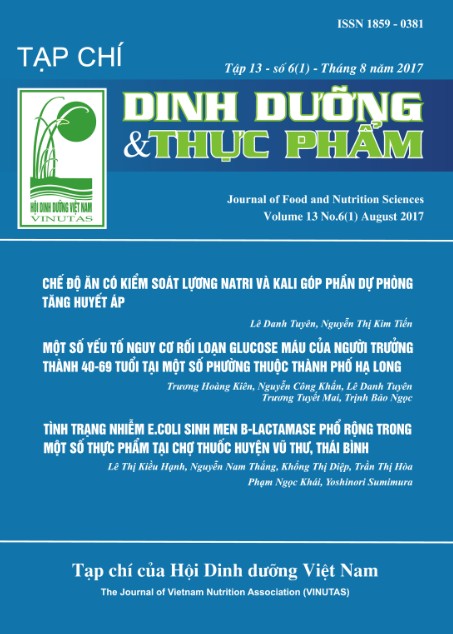OVERVIEW ON THE EFFECTS OF VARIETIES AND RIPENESS ON NUTRITIONAL VALUE AND BIOLOGICAL ACTIVITY OF CHERRY TOMATOES
Main Article Content
Abstract
Cherry tomato (Solanum Lycopersicum) belongs to Solanaceae family. The plants are small and dwarf. They can produce many fruits and are grown all year round all over the country; mainly in Da Lat. Cherry tomatoes are very preferred, having less pest and strong growth. Their fruits are small with a weight of 10 to 30g, usually in red color, but may also have other colors such as yellow, blue and even black. In fresh form, they are crispy, sweet and sour, but less sour than ordinary tomatoes.
Cherry tomatoes are a good source of nutrients and bioactive compounds. However, the nature and concentration of synthesized compounds are influenced by many factors, especially varieties and ripeness. Therefore, it is important to understand these factors in order to obtain the optimal material source.
Keywords
Varieties, ripeness, nutritional value, biological activity, cherry tomatoes
Article Details
References
2. La Vecchia, C. (1998). Mediterranean epidemiological evidence on tomatoes and the prevention of digestive tract cancers. Proc. Soc. Exp. Biol. Med.,218: 125-128.
3. Sies, H.; Stahl, W. (1998). Lycopene: antioxidant and biological effects and its bioavailability in the human. Proc.Soc. Exp. Biol. Med., 218: 121-124.
4. Beecher, G. R. (1998). Nutrient content of tomatoes and tomato products. Proc. Soc. Exp. Biol. Med., 218: 98-100.
5. Choi S. H, Kim D.-S., Kozukue N., Kim H.-J., Nishitani Y., Mizuno M.,, Levin C. E., Friedman M. (2014). Protein, free amino acid, phenolic, β-carotene, and lycopene content, and antioxidative and cancer cell inhibitory effects of 12 greenhousegrown commercial cherry tomato varieties. Journal of Food Composition and Analysis, 34: 115–127.
6. Egea I., Barsan C., Bian W., Purgatto E., Latché A., Chervin C., Bouzayen M., Jean-Claude J.-C. (2010). Chromoplast Differentiation: Current Status and Perspectives. Plant and Cell Physiology, 51(10): 1601-1611.
7. Paran I., van der Knaap E. (2007). Genetic and molecular regulation of fruit and plant domestication traits in tomato and pepper. Journal of Experimental Botany, 58(14): 3841-3852.
8. Barry C. S., Pandey P. (2009). A survey of cultivated heirloom tomato varieties identifies four new mutant alleles at the green-flesh locus. Molecular Breeding, 24(3): 269-276.
9. Gonzali S., Mazzucato A., Perata P. (2009). Purple as a tomato: towards high anthocyanin tomatoes. Trends in Plant Science, 14(5): 237-241.
10. Jones C. M., Mes P., Myers J. R. (2003). Characterization and Inheritance of the Anthocyanin fruit (Aft) Tomato. Journal of Heredity, 94(6): 449-456.
11. Shahzad T., Ahmad I., Choudhry S., Saeed M. K., Khan M. N. (2014). DPPH free radical scavenging activity of tomato, cherry tomato and watermelon: lycopene extraction, purification and quantification. International Journal of Pharmarcy and Pharmaceutical Sciences, 6 (2): 223-228.
12. Raffo A., Leonardi C. Fogliano V.,Ambrosino P., Salucci M., Gennaro L., Bugianesi R., Giuffrida F., Quaglia G. (2002). Nutritional value of Cherry Tomatoes (Lycopersicon esculentum Cv.Naomi F1) harvested at different ripening stages. Journal of Agricultural and Food chemistry, 50: 6550-6556.
13. Commission of the European Communities. (1993). Nutrient and Energy Intakes for the European Community. Reports of the Scientific Committee for Food (31st series). Office for Official Publications of the European Communities, Luxembourg


